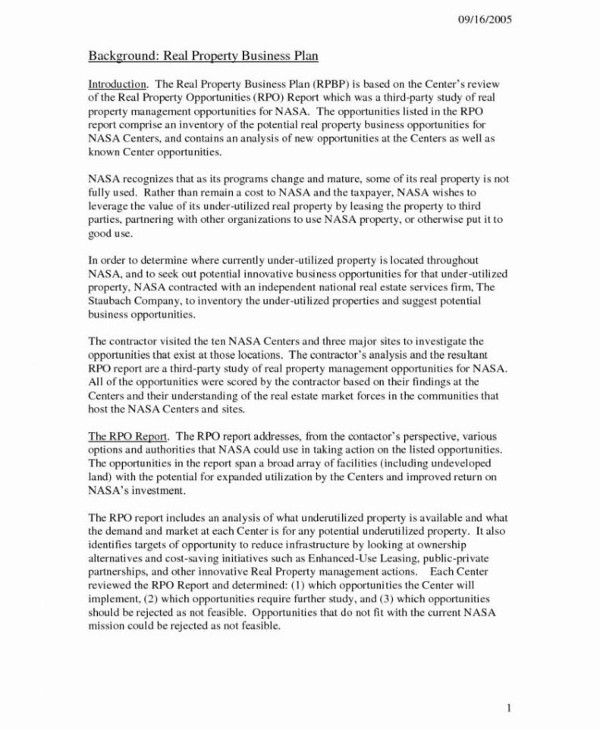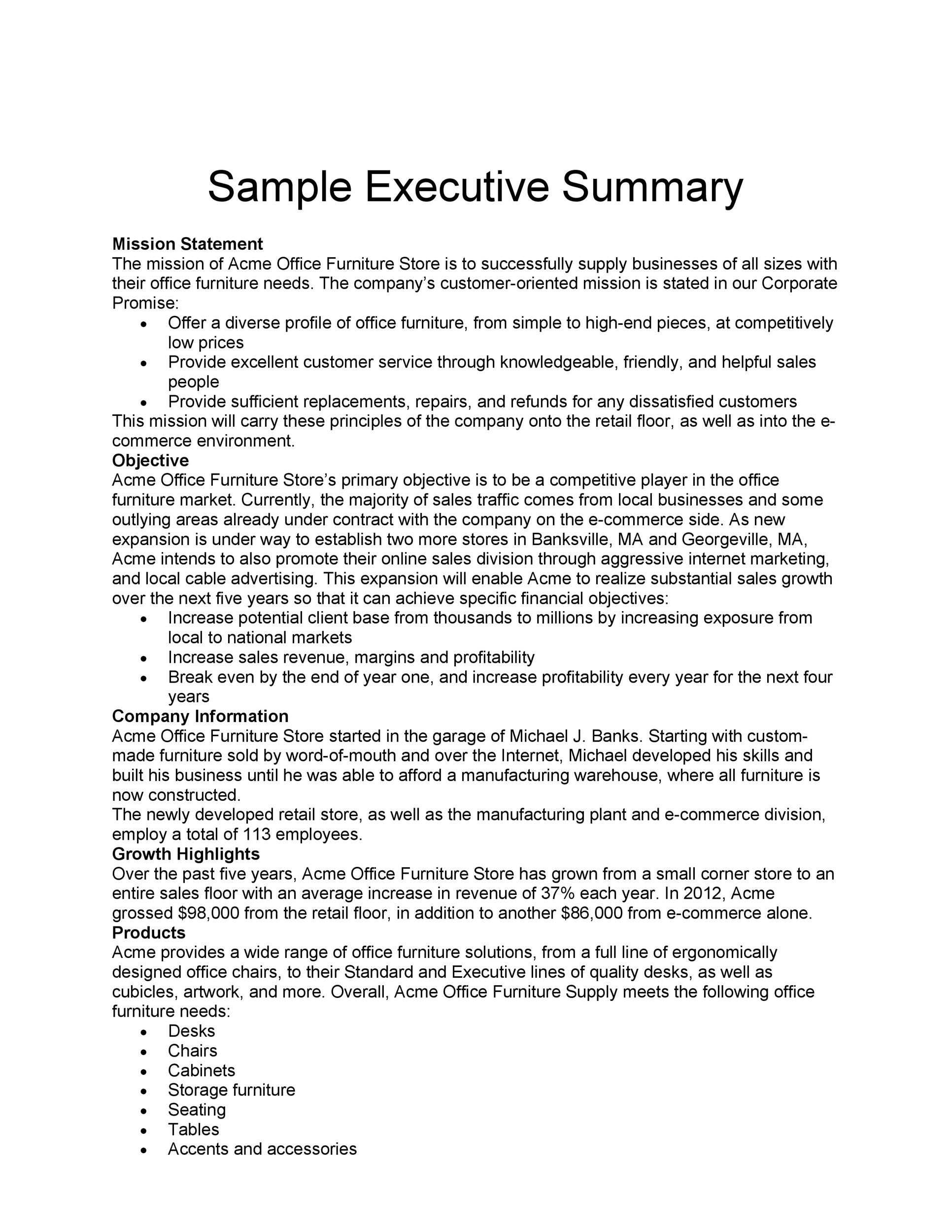The executive summary for a business plan is a brief, positive synopsis of the business that goes at the beginning of your business plan.3 min read
- Business Plan Executive Summary Outline
- Example Of Executive Summary Of Prospective Business Plan Example
- Example Of Executive Summary Of Prospective Business Plan
- Business Plan Executive Summary Sample
- Executive Summary Of A Business Plan
- Business Plan Executive Summary Template
Building Block 2 – The Business Plan and Executive Summary BUILDING BLOCK 2: The Business Plan and Executive Summary You will need to develop several investor communication documents or tools when raising money and interfacing with potential investors: 1. The elevator pitch 2. The executive summary. What is an Executive Summary Exactly? An executive summary is a non-technical summarized version of what is presented in the document. Students provide it in the beginning of the report and business owners provide it in the beginning of the business plan. But it is one of the main aspects in the business plan.
2. Tips for Writing the Executive Summary
What is an example of a good executive summary for business plan? The executive summary for a business plan is a brief, positive synopsis of the business that goes at the beginning of your business plan. It is normally about two pages long and contains two-sentence overviews of each section within the plan. Ideally, the reader will be able to quickly grasp the key elements of your business plan from the executive summary.
It is important that the executive summary not be a dry statement. If it is to entice readers to take an interest in your business, It should be clear, succinct, and engaging.
What Goes into an Executive Summary?
The content of the executive summary will vary between startups and established businesses. However, there are certain elements common to both:

- The name and location of the business.
- Your company's value proposition: What sets your company apart from your competitors?
- The marketplace need your company meets, with evidence of that need.
- The way your company's products and/or services meet that need.
- A description of your competition and the advantages your company has over them.
- A description of your target customer.
- An overview of your company's management team and how each member contributes to its success.
- A description of the company's current developmental stage.
- A financial summary, showing projected sales and profits for the next three years in a way that is both honest and convincing.
- If you are requesting money from a financial institution, state the specific amount you want. For investors, state the percentage stake in the company you're offering for their financial backing.
- A summary of major milestones so far and your goals for the future.
Startups should also include:
- A brief overview of your sales and marketing strategy.
- Your implementation plan, describing how you intend to get the business from planning to opening.
For established businesses, be sure to add:
- Your mission statement, which is a brief description of the purpose and values of the company.
- A short history of the company, including the products and/or services it provides and general statistics (number of employees, locations, etc.).
- An overview of how the business has grown, both in terms of revenue and market share.
- A financial summary for potential investors.
- A business road-map describing your plans for the company. This is also important for investors. They will want to see how you plan to use their money to grow the business.
When a business starts generating profits, its value can increase quickly. Be sure your executive summary spells out explicitly how the company's ownership is divided. For the summary, this need only be a simple statement to say, for example, that the five founding partners will receive 20 percent ownership each. Details can be negotiated later.
Tips for Writing the Executive Summary
- Write the executive summary after you have completed the entire business plan.
- Start the executive summary with a compelling case for why you have a great business idea. No matter how good the rest of the plan looks, no one is going to be interested in a bad idea.
- Keep the tone upbeat, but don't oversell. While you don't need to mention ordinary risks, it's OK to note unusual challenges. However, always be sure to highlight the positives.
- Write in concise language using layman's terms. Anyone without knowledge of your business should be able to understand your executive summary and recognize the opportunity it presents.
- Do not be ambiguous. Present a clear plan for your business. Multiple options convey indecision and uncertainty which are turn-offs for potential investors.
- Conclude your executive summary with a couple of sentences that tell the reader why your business will be successful. Again, keep the language positive and confident. Avoid “maybe” and “possibly.”
- When you've finished, read it back to yourself aloud. Make changes where sentences sound awkward or don't flow well. Then give it to someone who is unfamiliar with your business to read. Note their feedback.
The executive summary is the most important part of your business plan, but it need not be the hardest to write. If you've written the plan, you've already done most of the work. There are plenty of examples of executive summaries online to guide you further.

Business Plan Executive Summary Outline
If you need help with an example of a good executive summary for business plan, you can post your legal need on UpCounsel's marketplace. UpCounsel accepts only the top 5 percent of lawyers to its site. Lawyers on UpCounsel come from law schools such as Harvard Law and Yale Law and average 14 years of legal experience, including work with or on behalf of companies like Google, Menlo Ventures, and Airbnb.

Executive Summary
Definition
The first part of your business plan is your executive summary. An executive summary is a report, proposal, or portfolio, etc in miniature (usually one page or shorter). That is, the executive summary contains enough information for the readers to become acquainted with the full document without reading it. Usually, it contains a statement of the problem, some background information, a description of any alternatives, and the major conclusions. Someone reading an executive summary should get a good idea of main points of the document without becoming bogged down with details. For a business plan, the executive summary should high light three things – overview, objectives, and mission. I’ll summarize each with examples.
Overview
Step 1 – Summary
First, a short paragraph highlighting what your business is all about. Referred to your company in the third person. For example, instead of saying “my company is…” you say, “Company Name is…” Check out the example below. (click on image to enlarge)
Example Of Executive Summary Of Prospective Business Plan Example
Step 2 – The Market
The next part of the executive summary should discuss the market. This is a paragraph basically outlining the industry. So if you are starting up a bakery, you want to do some research on your niche or target market and summarize in a few sentences who will comprise your market. This is basic demographic information: city population, age, income, etc. Check out this example below. (click on image to enlarge)
Example Of Executive Summary Of Prospective Business Plan
Step 3 – The Business Model
This is a paragraph or two vaguely explaining the logistics of the business. You want to answer questions like how will the business run? or where is the office located? Do not go into too much detail. This basically helps you explain the who, what, where and leverages your credibility. Here is an example. (click on image to enlarge)
Step 4 – The Management Team
This is simple. Here is where you put a short biography of the qualifications of the management team. If it is you and another partner, write a short paragraph on each person involved. You want to make sure to explain what makes you capable, competent, and in control. Again, you want to do this in the third person. Here is an example. (click on image to enlarge)
Objectives
Business Plan Executive Summary Sample
Your objectives should range from three to five, statements that objective why you are starting up your company. These objectives should highlight unmet needs for your target market and not only justify the importance of starting up your company from the owners perspective, but also from the customers perspective. Check out the example below. (click on image to enlarge)
Mission
Executive Summary Of A Business Plan

The final part of your executive summary is a quick paragraph explaining your mission. Really, this is just recaping your objectives – only in complete sentences. When someone reads your mission, they should be able to understand why you are doing what you are doing, for whom, and how you will go about it. Check out the example below. (click on image to enlarge)
Business Plan Executive Summary Template
Alright! You’ve completed the first section of your business plan! You are already on your way to starting up your own business. Check out my other posts for more information. Also, you might want to check out a few of these helpful links that go into more detail on how to perfect your writing, templates, and more.
